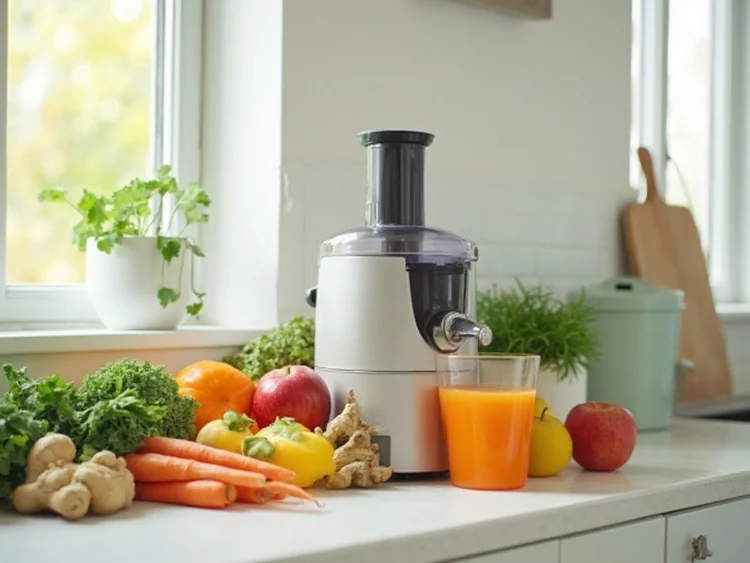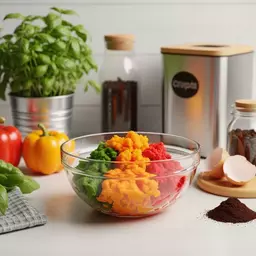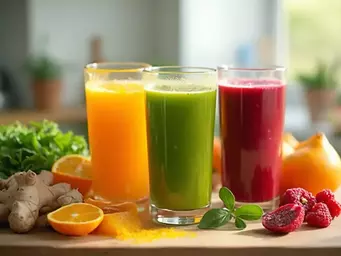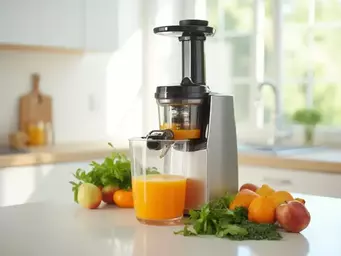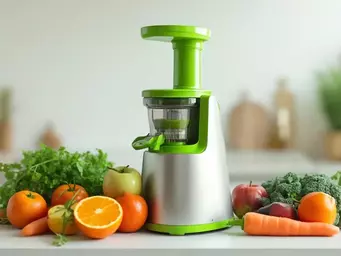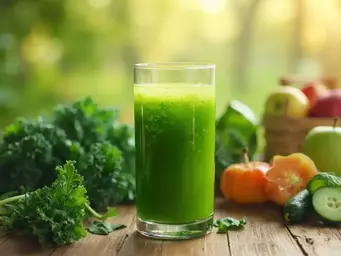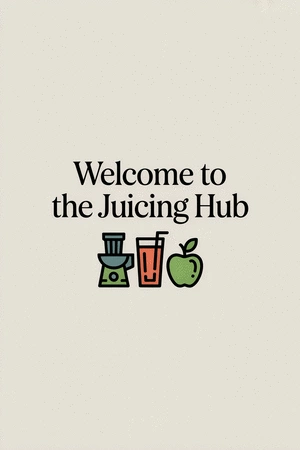Have you ever considered how your health choices impact the environment? Adopting a zero-waste juicing routine not only boosts your wellness but also nurtures our planet. Let's explore this mindful approach to juicing!
What You Will Learn
- Understanding zero-waste juicing and its benefits for both health and the environment.
- How to maximize the use of fruits and vegetables, ensuring minimal waste during the juicing process.
- The importance of sustainable practices, including supporting local farmers and reducing landfill waste.
- Practical tips for incorporating zero-waste habits into your daily juicing routine.
- Ways to engage your community and inspire others to join the zero-waste movement.
The Zero-Waste Juicing Cycle
This diagram illustrates the mindful approach to zero-waste juicing, focusing on maximizing ingredient use and minimizing environmental impact.
1. Plan & Source Sustainably
Plan juices to minimize leftovers. Choose seasonal, local, and organic produce.
2. Efficient Juicing
Maximize yield with effective juicer use. Store scraps for repurposing or composting.
3. Repurpose Leftovers
Utilize pulp and peels for snacks, soups, or composting. Get creative with all parts.
4. Share & Engage
Encourage others to join. Host juicing parties, share tips, build community gardens.
Understanding Zero-Waste Juicing and Its Importance
As a passionate health advocate, I often hear questions about how we can enjoy the benefits of fresh juice while being mindful of our impact on the planet. That’s where zero-waste juicing comes into play! By eliminating waste throughout the juicing process, we can indulge in delicious, nutritious juices without harming the environment. Let’s dive into what a zero-waste juicing routine looks like and why it matters!
Zero-waste juicing is all about maximizing the use of your ingredients and minimizing waste. It’s a mindful approach that not only benefits your health but also the planet. By developing a zero-waste routine, you can enjoy every part of your fruits and vegetables, ensuring that nothing goes to waste. Isn't that a fulfilling way to juice?
What is a Zero-Waste Juicing Routine?
A zero-waste juicing routine involves using every part of your produce—from skin to pulp—while focusing on sustainable practices. The idea is to create a system where you make the most out of your fruits and veggies. Here’s how you can build a solid routine:
- Plan your juices ahead of time to minimize leftover ingredients.
- Use the juicer efficiently by selecting produce that offers maximum yield.
- Get creative with leftover pulp and peels!
With a little creativity, your kitchen can transform into a hub of delicious, sustainable juicing. I find this approach not only reduces waste but also inspires new recipes and ideas!
Why Choose Sustainable Practices for Juicing?
Choosing sustainable practices for juicing isn't just about reducing waste; it's about creating a mindful lifestyle! When we prioritize sustainable methods, we contribute to a healthier planet and promote a culture of responsibility. Here are some compelling reasons to adopt these practices:
- Reduces landfill waste and greenhouse gas emissions.
- Supports local farmers by choosing seasonal and organic produce, which also offers higher nutritional value, as detailed in a study on organic food consumption and nutrient intake.
- Enhances community awareness around environmental issues.
By embracing sustainability, we not only take care of our health but also give back to the earth. It’s a win-win for everyone involved!
The Environmental Impact of Traditional Juicing Methods
Many traditional juicing methods can lead to significant waste and an increased environmental footprint. From excess packaging to discarded pulp, the impact is more substantial than we might realize. Understanding these effects is crucial for making informed choices in our juicing practices.
- Traditional juicing often generates a lot of pulp and peel waste.
- Store-bought juices frequently come with unnecessary plastic packaging.
- High energy consumption from appliances that aren’t energy-efficient.
By recognizing the environmental impact of our choices, we can shift towards more sustainable juicing practices. At The Juicing Hub, I'm committed to guiding you through methods that benefit both your health and the planet, aligning with principles of eco-friendly eating practices.
Pro Tip
To enhance your zero-waste juicing experience, consider utilizing your leftover pulp creatively. You can incorporate it into baked goods, like muffins or pancakes, or use it as a nutritious addition to soups and smoothies. This not only minimizes waste but also boosts the nutritional value of your meals!
Embracing a Sustainable Juicing Lifestyle
Transitioning to a sustainable juicing lifestyle is not just about what you juice but how you embrace the entire process. By incorporating zero-waste practices into your daily habits, you can make a significant impact on your health and the environment. Let’s dive into some practical steps to help you get started!
Incorporating Zero-Waste Practices into Daily Habits
One of the easiest ways to begin your zero-waste juicing journey is by adopting small, mindful habits in your kitchen. Here are some tips to help you integrate these practices:
- Plan your meals around seasonal fruits and vegetables to minimize waste.
- Store juicing scraps in a dedicated container for composting or repurposing.
- Use leftover pulp to create healthy snacks or add it to soups and smoothies.
- Invest in reusable produce bags to reduce plastic waste while shopping.
By making these adjustments, you’ll find that your juicing routine becomes not only more sustainable but also more fulfilling. Each small step contributes to a healthier planet!
Encouraging Others to Join the Zero-Waste Movement
As someone who is passionate about the art of juicing, I believe in the power of community. Sharing your journey and encouraging others can amplify the impact of sustainable practices. Here are some ways to inspire your friends and family:
- Host a juicing party where everyone brings their favorite fruits and vegetables.
- Share recipes and tips on social media, using the hashtag #ZeroWasteJuicing.
- Create a challenge to see who can come up with the most innovative uses for juice pulp!
Engaging others can create a ripple effect, making zero-waste juicing a shared goal that benefits everyone.
Building Community Gardens for Local Farming Initiatives
Another empowering aspect of embracing a sustainable juicing lifestyle is participating in community gardens. These initiatives not only provide fresh produce but also foster a sense of community and collaboration. Here’s how you can get involved:
- Join or start a local community garden project to grow your own organic fruits and vegetables.
- Organize workshops where you can teach others about juicing and sustainability.
- Collaborate with local businesses to source ingredients, further supporting the local economy.
By advocating for community gardens, we can create spaces where everyone can benefit from the joys of fresh, organic produce and sustainable practices. It’s a wonderful way to connect with others while making a positive environmental impact!
Take Action: Start Your Zero-Waste Juicing Journey Today
Now that you have some insights into embracing a sustainable juicing lifestyle, it’s time to take action! Let’s explore how you can expand your knowledge and engage with like-minded individuals.
Resources for Further Learning and Community Engagement
There are numerous resources available to help you deepen your understanding of zero-waste juicing. Consider these options:
- Join online forums and social media groups focused on sustainable living and juicing.
- Follow blogs like The Juicing Hub for recipes and tips that prioritize zero waste.
- Attend local workshops or webinars about sustainable cooking and gardening practices.
These resources will keep your inspiration alive and provide valuable connections to the community!
Share Your Experiences and Tips with Fellow Juice Lovers
Your journey is unique, and sharing your experiences can benefit others! Here are some ideas on how to share:
- Write a blog post or share a video on your favorite zero-waste juicing tips.
- Engage with followers on social media by posting daily juicing habits.
- Encourage dialogue by asking others about their own juicing practices.
By sharing, we learn from each other and strengthen our community's commitment to sustainability.
Exploring DIY Juicing and Its Benefits for Health and Wellness
Finally, consider diving into DIY juicing as a fun and rewarding way to enhance your wellness. Making your own juice allows you to control the ingredients and reduce waste. Plus, it’s a great way to experiment with flavors!
- Try creating your own juice blends using seasonal produce for maximum nutrition.
- Incorporate superfoods into your recipes for an extra health boost.
- Document your DIY juicing journey to inspire others to join in!
Each glass of juice you create is not just a drink; it’s a step toward a healthier you and a healthier planet! What exciting blends will you create?
A: Zero-waste juicing is a mindful approach to making juice that focuses on maximizing the use of all ingredients (from skin to pulp) and minimizing environmental waste throughout the entire process.
A: By using fresh, often organic and local produce, you ensure higher nutritional intake. Repurposing pulp into other meals can also add more fiber and nutrients to your diet.
A: It reduces landfill waste, minimizes greenhouse gas emissions, decreases plastic packaging reliance, and supports local, sustainable agriculture.
A: Pulp can be used in baked goods like muffins and breads, added to soups, smoothies, or even used to make vegetable broth. It can also be composted.
A: You can share your experiences and tips on social media, host juicing parties, participate in community gardens, and create challenges to inspire innovative uses for pulp.
A: You can join online forums, follow blogs like The Juicing Hub, and attend local workshops or webinars on sustainable cooking and gardening practices.
A: While juicing removes fiber, it concentrates vitamins and minerals. The fiber-rich pulp can be repurposed to ensure you still get those important nutrients. For more information on the impact of food processing on nutritional quality, you can refer to insights from a study published on PMC.
Recap of Key Points
- Zero-waste juicing maximizes ingredient use and minimizes waste, benefiting both health and the environment.
- Sustainable practices include using every part of produce, planning juices ahead, and creatively utilizing leftover pulp.
- Choosing sustainable juicing methods reduces landfill waste, supports local farmers, and raises community awareness.
- Engaging others in the zero-waste movement can amplify its impact through community challenges and sharing experiences.
- Participating in community gardens fosters collaboration and provides access to fresh, organic produce.
- Resources for further learning include online forums, blogs, and local workshops on sustainable living and juicing.
